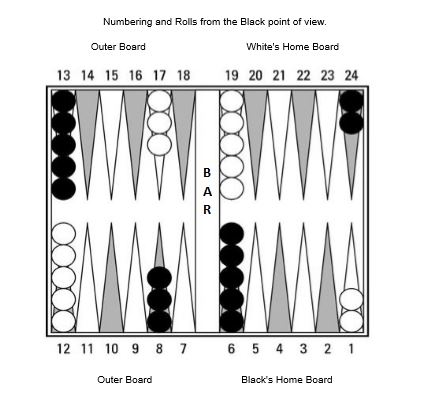Last updated on May 23, 2024
This Deluxe Backgammon post is another in our series for beginners and newcomers. Today we are going to take a look at the strategic value of the bar-point (7-point). The bar point is often overlooked or underestimated in discussions on backgammon.
The bar-point is the 7-point on your outer board. This point is highly important in the early stages of a game since a secure bar-point, together with the existing 6 and 8-points make a three-point prime. This point is named because it is immediately adjacent to the centre bar on the backgammon board. In the screenshot below, shown from the black checker’s perspective, the bar points are numbered 7 (black) and 18 (white).
Key points
Keeping in mind that the 6-point is secure at the start of play, the most valuable points early in the game are the two 5-points. These are closely followed by the bar-points and the 4-points. Other points elsewhere on the board are much weaker than these key blocking points. Even secure points deep in your home board are less valuable at the start of play and risk wasting material. For example, a secure ace-point in your home board offers blocking potential. However, the two checkers can’t be used elsewhere on the board and basically remain in place until it is time to bear off. This is the perfect example of wasted material.
Of the opening rolls, the 3-1 is used to secure the 5-point and is undisputedly considered the best opening roll. The third-best opening roll is considered to be the 6-1 and this is used to secure the bar-point. Any other move with a 6-1 would leave vulnerable checkers on unsecured points.
In the early game, the next most useful point after the 5-point, strategically speaking, is the bar-point. Even though it is not actually in your home board, which means it is not as useful as a blocking point if your opponent is trying to re-enter. However, it provides good priming potential and prevents the back checkers from escaping with a roll of 6. This completely nullifies the Lovers Leap roll of 6-5. As stated earlier, securing the bar-point creates a three-point prime, which creates a significant barrier.
Primes
The three-point prime from the 6 to 8-points creates a strong base from which to extend the prime further into your home board. Once you secure three or more points in your home board, you’re usually in a strong position, especially if your opponent hasn’t escaped their back checkers. Even if the back checkers have escaped, your opponent will be afraid of being hit because if they are, their chances of re-entering from the bar are limited. This would allow you to strengthen your position as they miss turns and remain on the bar.
On the other side of the board, holding the opponent’s bar point is also great for blocking. However, it has a slight disadvantage compared to holding the opponent’s 5-point. The bar-point can’t be used as a landing place to re-enter if you get hit. Even so, holding your opponent’s bar-point is still very useful in preventing your opponent from building a strong prime to trap your back checkers. Additionally, it provides a place to launch an attack on your opponent’s checkers as they enter the outer board. It also serves as a launchpad to start racing your checkers home. A high double roll might well provide the opportunity to escape.
Related content
Backgammon Galore, bar point definition.



My favourite backgammon opening move is the 6-1 because I can secure the bar point. This blocks my opponent from escaping one of their back checkers with a 6 and is the beginning of an effective prime.
Hi Brett. the 6-1 opening in backgammon is a good blocking move, but it doesn’t secure a home board point, which the slightly better rolls of 3-1 and 4-2 do. A secure home point in backgammon offers a blocking point to checkers re-entering from the bar. That said, I would be happy to open with the 6-1 in most games because it does offer that blocking opportunity. Keep playing and enjoy your backgammon, Jason.